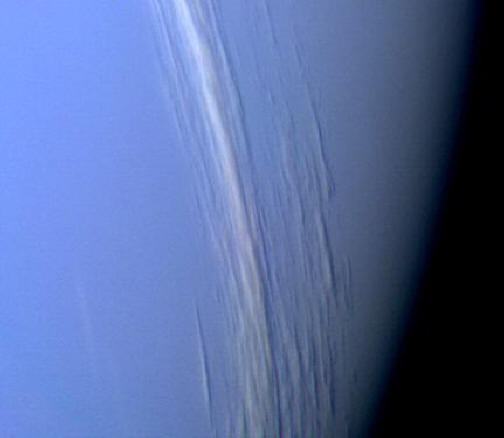


Electric Wind
Jan 21, 2009
It is the planets farthest from the Sun that have the fastest winds.
The average annual wind speed on Earth is approximately 56 kilometers per hour, with a maximum of 372 kilometer per hour gust recorded on Mount Washington, New Hampshire in 1934. On December 17, 1997 the US Weather Service recorded a maximum non-tornadic wind gust of 378 kilometers per hour on the island of Guam.
Some isolated wind phenomena, such as tornadoes and hurricanes, can sustain average velocities of 480 and 320 kilometers per hour for short periods. The maximum 24 hour speed record of 205 kilometers per hour from 1934 still remains, however. Atmospheric forces of that degree are enough to knock down heavily reinforced buildings, scour concrete roads away, blow cars and trucks around like leaves, and leave farmland completely denuded, including the topsoil.
Meteorologists are not sure how tornadoes form, but they are often associated with lightning storms. It seems that the key to understanding tornadoes is to think of them as rapidly rotating electric discharges. Just as copper wires carry electrons for power transmission, so do tornadoes. The difference is that electrons are moving at several centimeters per hour in a wire, while flying around at many meters per second in a tornado. The result is that the tornado forms an enormously powerful electromagnetic force field called a "charged sheath vortex."
It is commonly believed that weather is driven on Earth primarily by the Sun's thermal influence on the atmosphere. As we rotate beneath our primary, gases and dust absorb solar radiation at varying rates and in varying degrees. When any particular region heats up, the air expands and loses density, creating a relative low pressure area. Cooler air, being denser, will naturally flow into the bottom of the warm, low pressure region, causing an upwardly rotating convection cell to form.
Most weather systems on Earth are thought to be based on that simple kinetic explanation: winds blow when the cooler, denser air flows into the warmer, buoyant air.
The kinetic model of weather does not take into account the fact that planets much farther out in the Solar System have sustained winds that make those on our planet seem like gentle breezes. The average wind speeds on the gas giant planets are fantastic.
Jupiter's winds clock at 635 kilometers per hour around the Great Red Spot; Saturn's average wind speed is up to 1800 kilometers per hour; Uranus 900 kilometers per hour; and Neptune comes in at 1138 kilometers per hour. On Neptune the winds are blowing through an atmosphere that measures minus 220 degrees Celsius. Why is it that the most remote planets, receiving small fractions of the solar energy bathing Earth, are able to convert that small fraction into much larger effects?
As mentioned in a previous Picture of the Day, Earth is a small charged body moving in a large cell of plasma, so physical phenomena on or near the planet must take the electrical nature of plasma into account. Contemplating the larger picture will help to add new details to the study of everyday phenomena, such as the weather.
Perhaps lightning also powers the wind. Neptune has some of the strongest winds of any planet in the Solar System, yet it is farthest from the Sun—its frigid atmosphere contradict the thermal model of air movement. Perhaps hurricanes, tornadoes, and even prevailing winds are electrical in nature?
The Electric Universe hypothesis agrees with conventional theory that wind is movement of air molecules, but that there are other explanations. What are those other agents of movement?
If conventional theory explains wind solely as the result of convection and gas kinetics, Electric Universe proponents insist that electric discharges also generate wind. Electromagnetic forces in plasma move and accelerate charged particles, so collisions between charged and neutral particles drag the neutral air molecules along with them. Close observation of laboratory arc discharges reveals that an electric "wind" surrounds and often precedes an electric arc.
The plasma discharge sweeps up the surrounding air along with the charge carriers, or ions. The wind appears as inflows and updrafts as well as outflows and downdrafts. It can lift dust particles and erode surfaces. By analogy, we must then question the accepted explanation of thunderstorms as being caused solely by convection of hot air and the climatological movement of winds by the Sun's heat alone.
By Stephen Smith